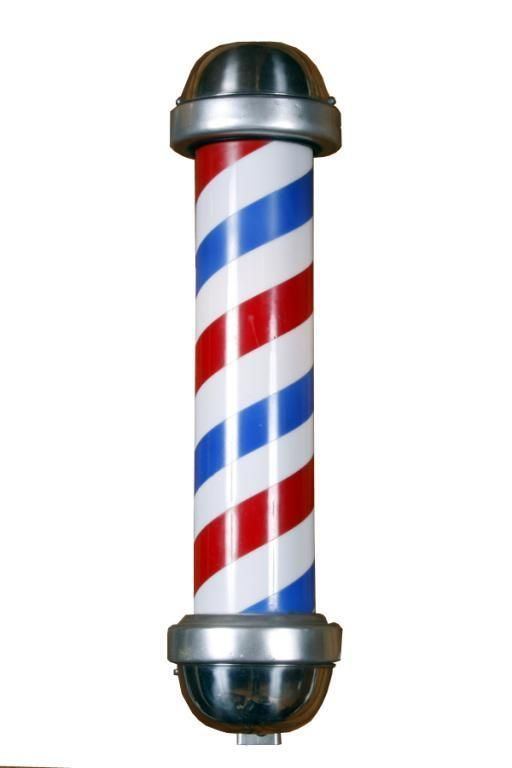 | ||
A barber's pole is a type of sign used by barbers to signify the place or shop where they perform their craft. The trade sign is, by a tradition dating back to the Middle Ages, a staff or pole with a helix of colored stripes (often red and white in many countries, but usually red, white, and blue in the United States). The pole may be stationary or may revolve, often with the aid of an electric motor.
Contents
- Origin in barbering and surgery
- Use in barbering
- Use in prostitution
- Visual illusion
- Visual similarity
- Animal husbandry
- Crustacea
- Entomology
- Ichthyology
- Candy
- Computer science
- Electronics
- Aviation and space flight
- Flyfishing
- Gambling
- Parachuting
- Meteorology
- Booksellers
- Border and lane markers
- Canadian Naval group
- Daymarks as a navigational aid
- Hockey
- Music
- Music acoustic illusion
- Trademark
- References
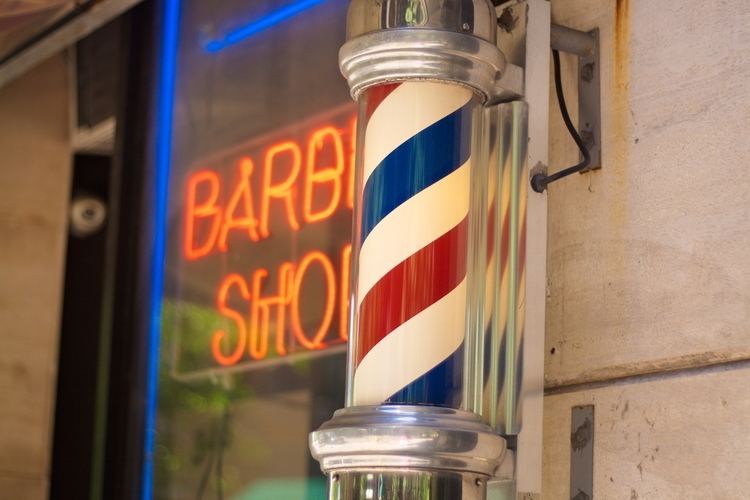
A "barber's pole" with a helical stripe is a familiar sight, and is used as a secondary metaphor to describe objects in many other contexts. For example, if the shaft or tower of a lighthouse has been painted with a helical stripe as a daymark, the lighthouse could be described as having been painted in "barber's pole" colors.
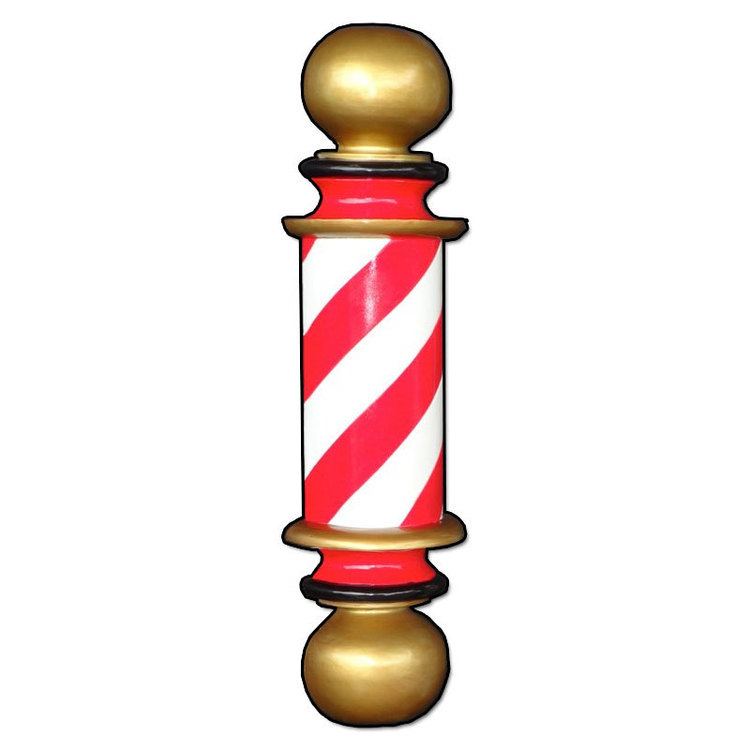
Origin in barbering and surgery
During medieval times, barbers performed surgery on customers, as well as tooth extractions. The original pole had a brass wash basin at the top (representing the vessel in which leeches were kept) and bottom (representing the basin that received the blood). The pole itself represents the staff that the patient gripped during the procedure to encourage blood flow.
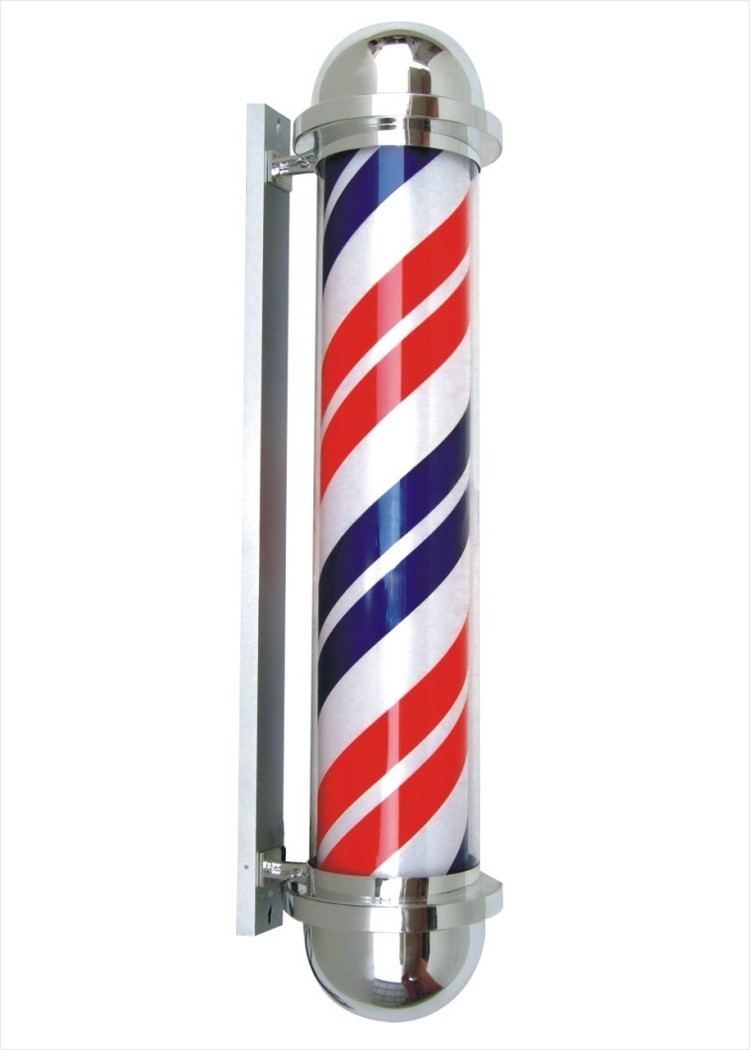
At the Council of Tours in 1163, the clergy was banned from the practice of surgery. From then, physicians were clearly separated from the surgeons and barbers. Later, the role of the barbers was defined by the College de Saint-Côme et Saint-Damien, established by Jean Pitard in Paris circa 1210, as academic surgeons of the long robe and barber surgeons of the short robe.
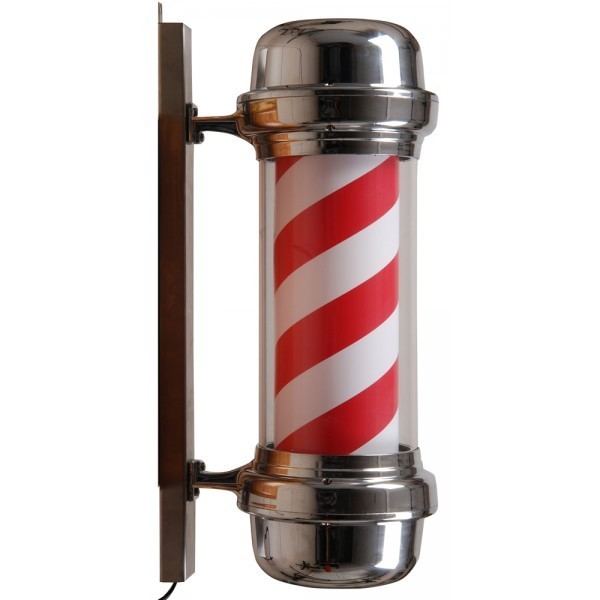
After the formation of the United Barber Surgeon's Company in England, a statute required the barber to use a blue and white pole and the surgeon to use a red pole. In France, surgeons used a red pole with a basin attached to identify their offices. Blue often appears on poles in the United States, possibly as a homage to its national colors. Another, more fanciful interpretation of these barber pole colors is that red represents arterial blood, blue is symbolic of venous blood, and white depicts the bandage.

Prior to 1950, there were four manufacturers of barber poles in the United States. In 1950, William Marvy of St. Paul, Minnesota, started manufacturing barber poles. Marvy made his 50,000th barber pole in 1967, and, by 2010, over 82,000 had been produced. The William Marvy Company is now the sole manufacturer of barber poles in North America, and sells only 500 per year (compared to 5,100 in the 1960s). In recent years, the sale of spinning barber poles has dropped considerably, since few barber shops are opening, and many jurisdictions prohibit moving signs. Koken of St. Louis, Missouri, manufactured barber equipment such as chairs and assorted poles in the 19th century.
As early as 1905, use of the poles was reported to be "diminishing" in the United States.
In Forest Grove, Oregon, the "World's Tallest Barber Shop Pole" measures 72 feet (22 m).
The consistent use of this symbol for advertising was analogous to an apothecary's show globe, a tobacconist's cigar store Indian and a pawn broker's three gold balls.
Use in barbering
The red and white pole outside barber shops references a time when barbers were expected to perform bloodletting and other medical procedures to heal the sick; red represented blood and white represented bandages. "Barber surgeons" in Rome also performed teeth extraction, cupping, leeching, bloodletting, surgery and enemas. However, today's barber poles represent little more than being a barber shop that cuts hair and does shaves. Barber poles have actually become a topic of controversy in the hairstyling business. In some states, such as Michigan in March 2012, legislation has emerged proposing that barber poles should only be permitted outside barbershops, but not traditional beauty salons. Barbers and cosmetologists have engaged in several legal battles claiming the right to use the barber pole symbol to indicate to potential customers that the business offers haircutting services. Barbers claim that they are entitled to exclusive rights to use the barber pole because of the tradition tied to the craft, whereas cosmetologists argue that they are equally capable of cutting men's hair too (though many cosmetologists are not permitted to use razors, depending on their state's laws).
Use in prostitution
In some parts of Asia, a red, white and blue barber pole is used as a symbol for a brothel. While prostitution is illegal in many parts of Asia, laws against it are often only enforced to the degree that all public solicitations for it are eliminated. The barber's pole is used as a euphemistic way of advertising a brothel, thus reducing the likelihood of police intervention.
In South Korea, barber's poles are used both for actual barbershops and for brothels. Brothels disguised as barbershops, referred to as 이발소 (ibalso) or 미용실 (miyongsil), are more likely to use two poles next to each other, often spinning in opposite directions, though the use of a single pole for the same reason is also quite common. Actual barbershops, or 미용실 (miyongsil), are more likely to be hair salons; to avoid confusion, they will usually use a pole that shows a picture of a woman with flowing hair on it with the words hair salon written on the pole.
Visual illusion
A spinning barber pole creates a visual illusion, in which the stripes appear to be traveling up or down the length of the pole, rather than around it.
Visual similarity
Animal husbandry
Haemonchus contortus, or "barber's pole worm", is the parasitic nematode responsible for anemia, bottle jaw, and death of infected sheep and goats, mainly during summer months in warm, humid climates. Humans may become infected by the worms.
Crustacea
Stenopus hispidus is a shrimp-like popcorn kernel decapod crustacean sometimes called the "barber pole shrimp." See also Stenopodidea.
Entomology
In the bug world, there is the barber pole grasshopper, Dactylotum bicolor. It is also known as the "painted grasshopper" and is said to be the "most beautiful" grasshopper.
Ichthyology
Because of its bright bands and colors, the redbanded rockfish Sebastes babcocki is referred to as "barber pole". Other pseudonyms include bandit, convict, canary, Hollywood, and Spanish flag.
Candy
The old-fashioned American stick candy is sometimes also referred to as "barber pole candy" due to its colorful, swirled appearance. See also, Candy cane. "Candy stripe" is a generic description of the candy cane color scheme. Among many other names, the candy has been called Polkagris.
Computer science
In UI design, a barber pole-like pattern is used in progress bars when the wait time is indefinite. It is intended to be used like a throbber to tell the user that processing is continuing, although it is not known when the processing will complete.
Barber pole is also sometimes used to describe a text pattern where a line of text is rolled left or right one character on the line below. The CHARGEN service generates a form of this pattern. It is used to test RAM, hard disks and printers. A similar pattern is also used in secure erasure of media.
Electronics
The strength and direction of magnetic fields and electric currents can be measured using a "magnetoresistive barber-pole sensor" (also called a "hermetic proximity sensor"), and its performance can be depicted using a mathematical formula. Such a sensor interleaves a series of permanent magnet strips with a series of magnetoresistive strips. The "conductive barberpole strips are canted across the sensor and connect one magnetoresistive strip, over a permanent magnet strip, to another magnetoresistive strip." This is said to provide a "uniform magnetic field throughout the sensor" thereby enhancing its resistance to external magnetic fields. The technology is used in wireless sensor networks which "have gathered a lot of attention as an important research domain" and were "deployed in many applications, e.g., navigation, military, ambient intelligence, medical, and industrial tasks. Context-based processing and services, in particular location-context, are of key interest ..." (See Music (acoustic illusion), infra.)
Aviation and space flight
The term on the barber pole is pilot jargon that refers to flying an aircraft at the maximum safe velocity. The airspeed Indicator on aircraft capable of flying at altitude features a red/white striped needle resembling a barber pole. This needle displays the VMO (Maximum Operating Velocity) or—at altitude—the MMO (Mach Limit Maximum Operating Speed) of the aircraft. This needle also indicates the maximum operating Mach number above the VMO/MMO changeover level. As the aircraft increases in altitude and the air decreases in density and temperature, the speed of sound also decreases. Close to the speed of sound, an aircraft becomes susceptible to buffeting caused by shock waves produced by flying at transonic speeds. Thus, as the speed of sound decreases, so the maximum safe operating speed of the aircraft is reduced. The "barber pole" needle moves to indicate this speed. Flying "on the barber pole" therefore means to be flying the aircraft as fast as is safe to do so in the current conditions.
Barberpole is a phrase used to describe the striped output of indicators used during the Apollo and Shuttle programs. Typically the indicator would show all grey or a grey and white striped pattern, known as barberpole, to allow the astronauts a quick visual reference of the status of the spacecraft systems. Various indicators in the Apollo Command Modules indicated barberpole when the corresponding system was inactive. Astronaut Jim Lovell can also be found describing system indications as "barber poled" in the transcript of radio transmissions during the Apollo 13 accident.
The phrase barberpole continues to be found in many subsystem descriptions in the Space Shuttle News Reference Manual, as well as the NASA/KSC Acronym List.
During World War I and World War II, the pattern has also been used as an insignia for aircraft identification. Spad XIIIs of the 94th Aero Squadron USAS in early 1919 used variations on barber pole patterns including: 'Barber Pole' of Lt Dudley 'Red' Outcault; S.16546 'Flag Bus' of Captain Reed Chambers; and 'Rising Sun' of Lt John Jeffers.
Flyfishing
Used in flyfishing, Au Sable River guide Earl Madsen's "Madsen's Barber pole" is a traditional Michigan fly in the form of a "Stonefly" imitation "with grizzly hackle tip wings tied in a downwing fashion." Photo of Madsen's Barber Pole Fly, parachute form.
Gambling
The phrase barber pole is derisive jargon in craps, and refers to the commingling of "gaming cheques of different denominations." Wagers that combine different denominations are "supposed to be stacked with the highest denomination at the bottom."
Parachuting
Meteorology
Booksellers
Red or rubric posts were sometimes used by booksellers in England prior to 1800. William Roberts reports in The Book Hunter in London that certain 18th-century bookshops in the Little Britain district of London sported such poles:
A few years before Nichols published [in 1816] his Literary Anecdotes, two booksellers used to sport their rubric posts close to each other here in Little Britain, and these rubric posts were once as much the type of a bookseller's shop as the pole is of a barber's ... Sewell, Cornhill, and Kecket and De Hondt, Strand, were among the last to use these curious trade signs.
Border and lane markers
Canadian Naval group
The famous Barber Pole Group was originally a group of 120 Flower-class corvettes built in Canada during World War II, and charged primarily with protecting freighter convoys. The original group was Escort Group C-3. This group of ships, with its red and white barber pole stripes painted on the funnel, is still represented in the current Royal Canadian Navy: all Atlantic fleet ships wear this insignia. HMCS Sackville is the last remaining Flower-class corvette.
Daymarks as a navigational aid
Hockey
Music
The "Barberpole Cat" group, a/k/a "Polecats"—perhaps a portmanteau of "barber's pole" and "catalogue"—is an essential repertoire of 12 songs that every barber shop quartet should know. The Barberpole Cat Program was created many years ago and features popular Barbershop songs arranged and voiced so all singers can learn and participate. For decades these have been the standard arrangements where singers can meet at conventions and sing together having never met before.
The songs in this collection are:
The Polecats have had a version 2.0 with additional songs added.
Music (acoustic illusion)
See also, Buchla 200 series Electric Music Box and Buchla 200e.
Trademark
Barbasol cans use a barber pole motif. Barbasol Can image. The can's motif is a registered trademark of Barbasol.
